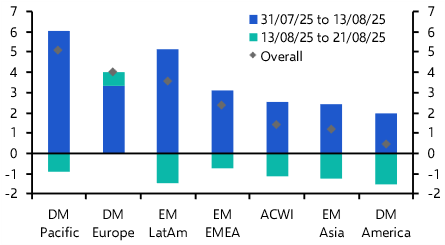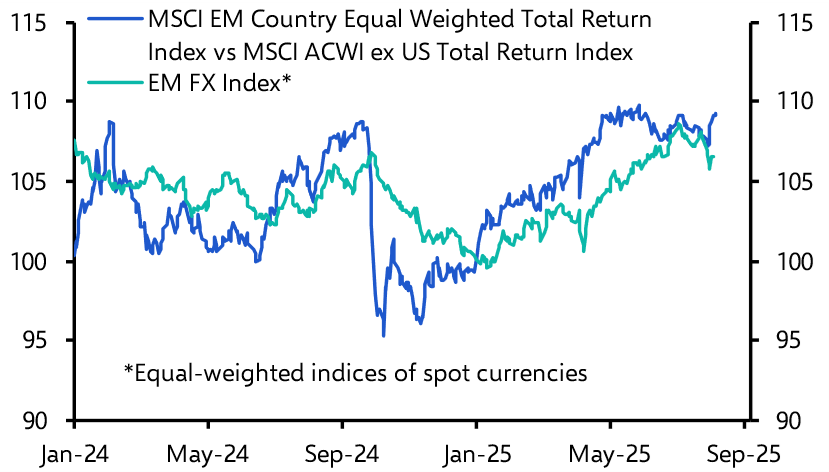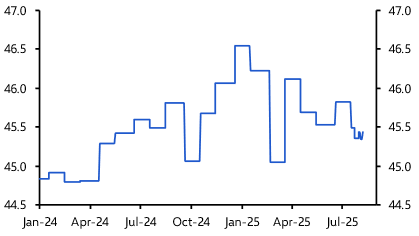
The implications of AI hype for asset returns
Q3 Asset Allocation Outlook

The prospects for risky assets in 2024 are much rosier, in our view. The makings of an (AI-fuelled) stock market bubble seem to be in place, and such bubbles can inflate for years before bursting.
This is a sample of our latest quarterly Asset Allocation Outlook, originally published on 27th June, 2023. Some of the forecasts contained within may have changed since publication. Access to the complete report, including detailed forecasts and near to long-term analysis, is available as part of a subscription to our CE Advance premium product or to our dedicated Asset Allocation coverage.
Q2 looks set to go down as a decisive victory for “risky” assets over “safe” ones, thanks in large part to euphoria in the stock market over Artificial Intelligence (AI). But we suspect that the story over the remainder of 2023 will be rather different, with safe assets regaining some ground on risky ones.
After all, while we think AI has brightened the outlook for the stock market, we still expect equities to falter over the rest of 2023 as the US and other advanced economies tip into recession and risk appetite sours; and, at the same time, we think sovereign bonds will rally as investors discount earlier and/or more aggressive easing from central banks.
The prospects for risky assets in 2024 are much rosier, in our view. The makings of an (AI-fuelled) stock market bubble seem to be in place, and such bubbles can inflate for years before bursting. As a result, we think equities (particularly those in the US technology sector) are set for a rip-roaring 2024. And while AI is less of a tailwind for credit markets, we envisage them benefiting from an improving economic backdrop. So, while we also expect positive returns from safe assets as yields fall further, we expect risky assets to outperform.
Chart 1: Actual & Projected Returns (US Dollars, %) |
|
|
-
We expect “safe” assets to generally outperform “risky” ones over the rest of 2023 as advanced economies enter recessions. But beyond that, we think risky assets, and particularly equities, are set to provide strong returns.
-
Most safe assets have struggled in Q2 so far. (See Chart 2.) That’s primarily been because investors have returned to a view that interest rates are set to remain “higher for longer”. In developed markets, the paring back of rate expectations seen after the US regional banking issues has generally reversed as much of the economic data, particularly in the US and UK, has come in stronger than many had expected. (See Chart 3.) Accordingly, most 10-year government bond yields have risen
Chart 2: Historical Index Returns,
|
Chart 3: Policy Rates (%) |
|
|
|
-
Based on the relationship between bond yields and equities over the past few years, the rising valuation and positive returns from the US stock market of late seem, on the surface at least, tough to square with that ratcheting up of rate expectations. (See Chart 4.) Indeed, when the higher-for-longer narrative took hold in February this year, equities sold off. But as we’ve pointed out before, the positive correlation between the returns from US equities and Treasuries, for example, is not set in stone over longer periods of time. (See Chart 5.)
Chart 4: 10-Year TIPS Yield & S&P 500 12M Forward Earnings Yield (%) |
Chart 5: Rolling Correlations Of Monthly Returns From US Equities & 10-Year Treasuries Since 1950 |
|
|
|
-
In fact, one period where the correlation began to turn negative was during the late 1990s. A clear parallel between that period and today is that excitement surrounding a potentially transformative technology was a key driver of equity markets. Back then it was the internet, and this time round it appears to be AI. The boost to the valuation of the S&P 500 from the AI hype has helped to push measures of the equity risk premium down to fresh post-dot com lows. (See Chart 6.)
-
In the near term, we’d be surprised if those measures declined much further. For one, we expect the 10-year Treasury yield to fall alongside equivalent government bond yields elsewhere over the rest of this year, as advanced economies enter recessions and more aggressive cutting cycles are priced in for major central banks. (See Chart 3 again.) Such a scenario would, in our view, also be consistent with a reversal of the recent rise in equity valuations as risk appetite suffered.
-
We also think there is potential for recessions to weigh on earnings expectations for corporate equities, not least given the partial recovery they have seen over the past few months. And relatedly, we think there’s probably scope for corporate credit spreads to tick back up too as the economic outlook darkens. (See Chart 7.) Taken together, that all suggests to us that government bonds will outperform equities and corporate bonds in the near term.
Chart 6: Measures Of US Equity Risk Premium (S&P 500 12M Fwd Earnings Yield Less Real Yields, %-pts) |
Chart 7: S&P 500 12M Forward Earnings Per Share & Sales Per Share & ICE BofA US High Yield Credit Spread |
|
|
|
-
Beyond the end of this year, though, we think risky assets will be well set to stage a comeback and provide superior returns to safe ones. Equities are the asset class that we expect to provide the best returns from 2024. (See Chart 8.) We don’t think the mild sell-off in equities we anticipate over the next six months will put too much of a dampener on AI enthusiasm, and think that it could fuel strong returns from the US stock market in particular.
-
Outside of the US, we still expect decent returns from most other developed market (DM) equity indices that we track. Although the absence of major tech firms in other DM equity indices suggests to us that local-currency returns from them are likely to lag the MSCI USA Index. Elsewhere, we think some emerging market regional indices could provide solid returns too.
-
That said, we do see returns from some non-US equity indices being boosted in common-currency terms from a weaker US dollar from 2024. (See Chart 9 and our FX Markets Service.)
Chart 8: CE Projected Index Returns* (US$, %) |
Chart 9: CE Forecast Changes In Currencies Vs US Dollar (%) |
|
|
|
Chart Sources: Bloomberg, Refinitiv, Shiller, Capital Economics
This is a sample of an 18-page report published for Capital Economics clients on 27th June, 2023. The original report was written by John Higgins, Adam Hoyes and James Reilly.

Make informed investment decisions quickly
CE Advance, our new premium product, equips organisations with actionable macroeconomic data and insight to stay ahead of the curve.



